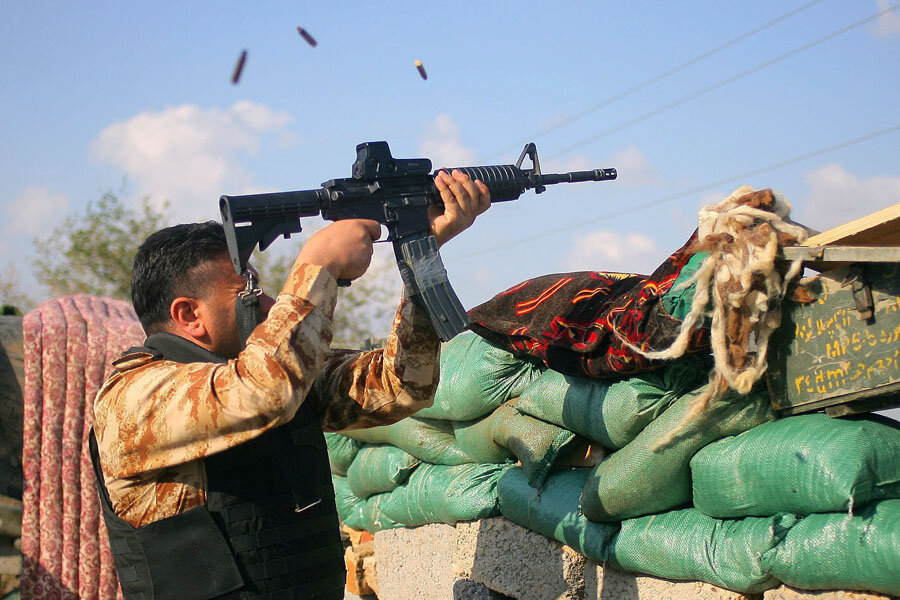Briefing: Who is battling Islamic State in Iraq?
Loading...
Disparate groups have a common goal in defeating the self-proclaimed Islamic State, but sectarian strains remain. Iran, Kurds, Shiite militias, and even some Sunnis want to see the extremists defeated, and a major military operation continues in Tikrit, in northern Iraq. It's unclear whether the coalition can survive the battle and, more important, a possible victory.
How have Iraq’s Shiite Arab parties and militias come to lead the fight?
When the self-described Islamic State marched into Mosul, a major northern city in Iraq, last June, whole divisions of the Iraqi Army collapsed and fled. The hollowness of the Iraqi Army – largely the result of a corrupt, self-interested leadership – coupled with the genocidal intent of IS to wipe out not only Iraq’s Shiite majority but also its religious minorities have drawn Shiite militias front and center into the fight.
Earlier this month, Gen. Martin Dempsey, chairman of the Joint Chiefs of Staff, estimated that around 20,000 Shiite militia fighters were involved in the offensive against IS in the battle for the Sunni Arab city of Tikrit (about 80 miles north of Baghdad) and its outlying towns. The Iraqi Army supplied only 2,000 soldiers in the effort.
Led by firebrand cleric Moqtada al-Sadr, these fighters – who are aligned with the Supreme Islamic Council in Iraq, one of the country’s largest Shiite Islamist parties – had taken on both US forces and Sunni insurgents during the US occupation of the country. Today, along with the forces of Qais Khazali, who created his own League of the Righteous militia, the militias are engaged in fighting against IS across much of Iraq’s center and north.
The ultimate goal of the men in charge of these militias is to see Shiite supremacy maintained in Iraq, a supremacy made possible after the United States toppled the Sunni-dominated regime of Saddam Hussein in 2003. Almost all of the militia took part in the ferocious sectarian fighting that erupted across the country in 2006 after an important Shiite shrine in Samarra was bombed by Al Qaeda in Iraq (AQI), the group that gave birth to IS.
What is Iran’s role in Iraq?
Iran’s interests are pretty much aligned with those of the Shiite militias. The US invasion of Iraq removed a staunch enemy from Tehran’s western border and ushered in a series of governments in Iraq. The nation, meanwhile, was flooded with returning Shiite Islamist activists, many of whom were supported in exile by Iran.
Qassem Soleimani, a senior general in Iran’s Revolutionary Guard Corps, has been a frequent visitor to Iraq’s front lines, and Iraqi Shiite fighters have been full of praise for Iran’s unwavering military support for their organizations.
Iran would like the status quo of a few years ago returned – with Iraqi territory under control of the friendly Baghdad government.
Where does this leave Iraq’s Sunni politicians and tribes?
Many Iraqi Sunni Arabs are caught in the middle. They don’t want to be ruled by the violent radicals of IS, but they also fear the Shiite-led central government, and for good reason: After US forces left Iraq in December 2011, the country’s then prime minister, Nouri al-Maliki, embarked on a campaign of politically motivated arrests and prosecutions against members of Sunni militias, who had fought against AQI in exchange for promises of future government jobs and protections. Iraq’s Sunni Arab vice president, Tariq al-Hashimi, was driven into exile.
In December 2013, the violent dispersal of a Sunni protest camp in Ramadi, the capital city of Anbar Province, left at least 10 dead, driving many Sunni Arabs back to the insurgency. In the months following, IS pursued an assassination campaign targeting many of the Sunni tribal leaders who reject their harsh brand of Islamic law.
More recently, reports indicate that Iraqi security forces and allied militia have destroyed and looted Sunni villages retaken from IS. While Mr. Maliki was replaced as prime minister by Haider al-Abadi last August, Mr. Abadi hails from the same Shiite Islamist political party and has shown little ability to win the support of the Sunni majority tribes.
What about the independent Kurds?
Iraq’s Kurdish minority has managed to carve out an enclave in the northeast of the country that is so autonomous it is independent in all but name. IS has posed a threat to Iraq’s Kurds – but also created an opportunity, allowing them to spread their sphere of influence to the oil-producing city of Kirkuk, which remained in central government hands until last summer.
While the Kurds would like to see IS defeated (its forces almost managed to reach the Kurdish capital of Erbil last summer) their interests are not Iraqi nationalist ones. The Kurds and Baghdad have been locked in a dispute over the sharing of oil revenues; the Kurds allege the central government owes them $1 billion a month, which has yet to be paid.
While their peshmerga fighters have proved to be among the most capable in Iraq in taking on IS, the Kurdistan Regional Government’s willingness to throw its soldiers into what’s likely to be a meat grinder of a battle to retake Mosul – a city with a Kurdish minority population – is at best unclear.








